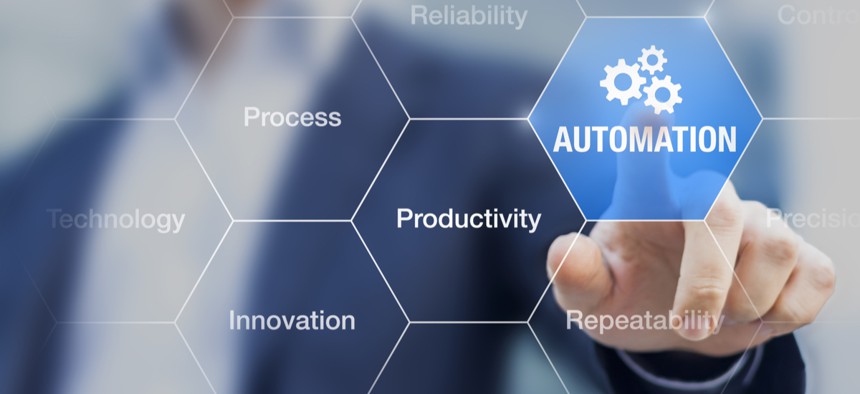CMS Produces ‘Employee Roll Call Bot’ to Account for Workforce Amid Telework

NicoElNino/Shutterstock
Teleworking can make it tough for agencies to keep a pulse on their personnel, but bots can help.
The COVID-19 pandemic rapidly necessitated agencywide telework at the Centers for Medicare and Medicaid Services.
To help keep its top officials abreast of employees’ statuses and conditions throughout the unprecedented disruption, the agency teamed up with UiPath to swiftly launch the CMS Employee Roll Call Bot.
“It was identified that there was no single source of information across the agency that provided complete personnel accountability data and provided a way to visually display the information to easily inform senior leaders,” a CMS spokesperson recently told Nextgov regarding what prompted the agency’s pursuit of the new tool when COVID-19 hit. “The bot was quickly developed in conjunction with UiPath to maintain visibility of multiple aspects of personnel accountability during the pandemic.”
The official, as well as UiPath’s Vice President of Federal Chris Townsend briefed Nextgov on the agency’s newest robotic process automation and others in place, and the two also pinpointed how deploying automated technology can help heighten the federal workforce’s productivity and morale.
Townsend explained that as CMS was first coping with its new pandemic-induced teleworking reality earlier this year, the agency began discussing a range of RPA options with the tech company. The Centers’ senior leaders were particularly interested in leveraging an automated bot that could monitor its internal systems and identify cases where employees who are working remotely are forced to confront challenges with connectivity, communications or access to CMS’ systems. Essentially, the Roll Call Bot can catch indications that employees aren’t logging on or accessing appropriate systems—which Townsend noted “might be an indicator that they're having a health issue.”
“It’s a way to keep a pulse on your organization without being so intrusive,” he said. “And it’s not in a ‘Big Brother’ way at all. All it's doing is monitoring their internal systems for their teleworkers to ensure that no one is having issues accessing their internal systems.”
In the bot’s production, CMS senior leaders called for the inclusion of data that enveloped the number of employees teleworking, the number of employees on leave—either routine or sick—and the number of employees connecting to the agency network, according to its spokesperson. The tool provides a “daily report,” the CMS official noted, which includes information at the agency level and also enables users to drill down to subordinate organizational levels for further insights.
“The bot is able to contribute to the information immediately available to decision-makers to maintain visibility on the agency’s ability to perform its mission,” the official said.
The Roll Call Bot is the only RPA resource the agency implemented so far that was specifically sparked by the pandemic. The agency’s spokesperson said that although the COVID-19 public health emergency hasn’t had an incredibly significant impact on the agency’s automation-driven efforts, “it did further support the value of RPAs and gave the team the opportunity to show how quickly they could develop a solution to a challenge.”
The agency is still in the “very early stages of its RPA journey, with six bots either in development or production,” they noted. The Location Analysis Bot marked the agency’s first pursuit of the nascent-to-government automated tools, and was produced roughly two years ago. It is able to spot the location of CMS credential applicants across the U.S. and then, through an analysis of known credentialing facilities, the bot subsequently identifies the closest servicing facility. From there, the tool initiates coordination for appointments for the customer to continue the credentialing process.
“It was obvious once this bot was deployed how it performed less complex, routine tasks freeing up the employees previously performing these tasks to shift their effort to more complex, higher level tasks,” the official said. “Since then, interest around RPA has grown and now we have bots being developed to perform tasks around a pretty diverse set of tasks.”
Some of those CMS-specific activities RPA is now supporting include: unclaimed property collection, bankruptcy tracking, internal move visibility and large volume personnel action processing. And similar to the agency’s sentiments, Townsend also said that in his work helping CMS and other agencies harness the support of automation, he too has witnessed firsthand the effects it can have on personnel. He said while new users at first often express initial trepidations about RPA replacing their jobs, once they give automated tools a chance, “it becomes a digital assistant for them that allows them to offload a lot of the mundane parts of their job that they hate—and it really improves morale, and gets people more excited because they can offload the most boring part of their jobs, have that automated and then focus on how they can better serve their customers, or their constituents, depending on their job function.”
To date, CMS’ automation-focused efforts have been executed at the group level, “with little enterprise-level oversight,” the spokesperson said. Now, the agency’s RPA team is in the midst of determining the proper level of enterprise oversight, while maximizing its ability to implement the tools.
“The processes performed by bots at CMS are tasks that employees see the value in but just don’t have the time in their day to perform, or they are forced to commit so much time to perform that it is preventing them from executing other duties,” the official said. “Employees have reacted favorably when, through an RPA, they realize they can do both.”
NEXT STORY: Government Innovation in a Global Pandemic






